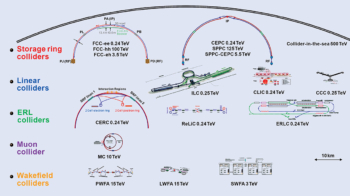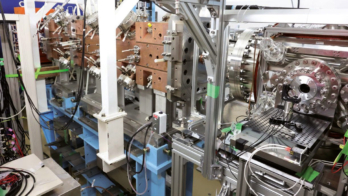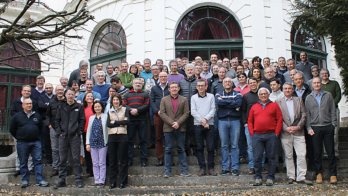The European X-ray Free-Electron Laser will probe electronic, chemical and biological processes in unprecedented detail.
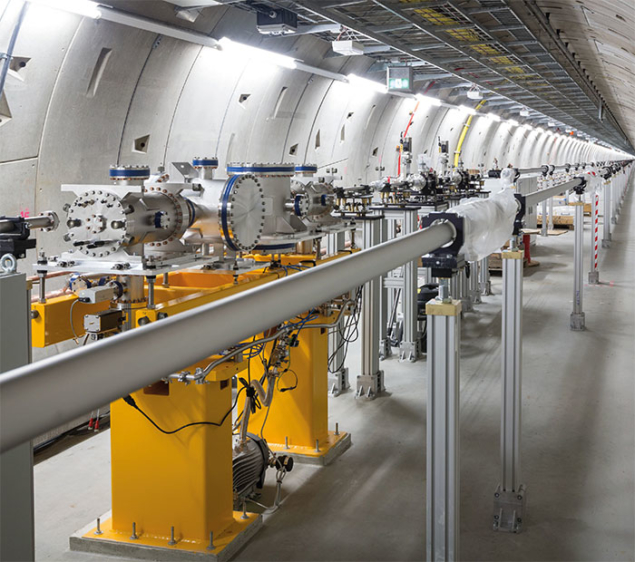
Image credit: European XFEL.
The past few decades have witnessed an explosion in X-ray sources and techniques, impacting science and technology significantly. Large synchrotron X-ray facilities around the world based on advanced storage rings and X-ray optics are used daily by thousands of scientists across numerous disciplines. From the shelf life of washing detergents to the efficiency of fuel-injection systems, and from the latest pharmaceuticals to the chemical composition of archaeological remains, highly focused and brilliant beams of X-rays allow researchers to characterise materials over an enormous range of length and timescales, and therefore link the microscopic behaviour of a system with its bulk properties.
So-called third-generation light sources based on synchrotrons produce stable beams of X-rays over a wide range of photon energies and beam parameters. The availability of more intense, shorter and more coherent X-ray pulses opens even further scientific opportunities, such as making high-resolution movies of chemical reactions or providing industry with real-time nanoscale imaging of working devices. This boils down to maximising a parameter called peak brilliance. While accelerator physicists have made enormous strides in increasing the peak brilliance of synchrotrons, this quantity experienced a leap forward by many orders of magnitude when the first free-electron lasers (FELs) started operating in the X-ray range more than a decade ago.
FLASH, the soft-X-ray FEL at DESY in Hamburg, was inaugurated in 2005 and marked the beginning of this new epoch in X-ray science. Based on superconducting accelerating structures developed initially for a linear collider for particle physics (see “The world’s longest superconducting linac”), it provided flashes of VUV radiation with peak brilliances almost 10 orders of magnitude higher than any storage-ring-based source in the same wavelength range. The unprecedented peak power of the beam immediately led to groundbreaking new research in physics, chemistry and biology. But importantly, FLASH also demonstrated that the amplification scheme responsible for the huge gain of FELs – Self Amplified Spontaneous Emission (SASE) – was feasible at short wavelengths and could likely be extended to the hard-X-ray regime.
The first hard-X-ray FEL to enter operation based on the SASE principle was the Linac Coherent Light Source (LCLS) at SLAC National Accelerator Laboratory in California, which obtained first light in 2009 using a modified version of the old SLAC linac and operates at X-ray energies up to around 11 keV. Since then, several facilities have been inaugurated or are close to start-up: SACLA in Japan, Pohang FEL in South Korea, and Swiss-FEL in Switzerland. The European X-ray Free-Electron Laser (European XFEL) in Schenefeld-Hamburg, Germany, marks a further step-change in X-ray science, promising to produce the brightest beams with the highest photon energies and the highest repetition rates. Construction of the €1.2 billion facility began in January 2009 funded by 11 countries: Denmark, France, Germany, Hungary, Italy, Poland, Russia, Slovakia, Spain, Sweden and Switzerland, with Germany (58%) and Russia (27%) as the largest contributors. It is expected that the UK will join the European XFEL in 2017.

Image credits: European XFEL.
The European XFEL extends over a distance of 3.4 km in underground tunnels (figure 1). It begins with the electron injector at DESY in Bahrenfeld-Hamburg, which produces and injects electrons into a 2 km-long superconducting linear accelerator where the desired electron energy (up to 17.5 GeV) is achieved. Exiting the linac, electrons are then rapidly deflected in an undulating left–right pattern by traversing a periodic array of magnets called an undulator (figure 1, bottom right), causing the electrons to emit intense beams of X-ray photons. X-rays emerging from the undulator, via 1 km-long photon-transport tunnels equipped with various X-ray optics elements, finally arrive at the European XFEL headquarters in Schenefeld where the experiments will take place.
In addition to the development of the electron linac, which was commissioned earlier this year and involved a major effort by DESY in collaboration with numerous other accelerator facilities over the past decade (see “The world’s longest superconducting linac”), the European XFEL has driven the development of both undulator technology and advanced X-ray optics. This multinational and multidisciplinary effort now opens perspectives for novel scientific experiments. When fully commissioned, towards the end of 2018, the facility will deliver 4000 hours of accelerator time per year for user experiments that are approved via external peer review.
Manipulating X-rays
Synchrotron radiation was first detected experimentally at Cornell in 1947, and the first generation of synchrotron-radiation users were termed “parasitic” because they made use of X-rays produced as a byproduct of particle-physics experiments. Dedicated “second-generation” X-ray sources were established in the early 1970s, while much more brilliant “third-generation” sources based on devices called undulators started to appear in the early 1990s (figure 2). The SASE technology underpinning XFELs, which followed from work undertaken in the mid-1960s, ensures that the produced X-rays are much more intense and more coherent that those emitted by storage rings (see SASE panel below). Like the light coming from an optical laser, the X-rays generated by SASE are almost 100% transversely coherent compared to less than one per cent for third-generation synchrotrons, indicating that the radiation is an almost perfect plane wave. Even though the longitudinal-coherence length is not comparable to that of a single-mode optical laser, the use of the term “X-ray laser” is clearly justified for facilities such as the European XFEL.

Image credit: European XFEL.
A major challenge with X-ray lasers is to develop the mirrors, monochromators and other optical components that enable high-energy X-rays to be manipulated and their coherence to be preserved. Compared with the visible light emerging from a standard red helium-neon laser, which has a wavelength of 632 nm, the typical wavelength of hard X-rays is around 0.1 nm. Consequently, X-ray laser light is up to 6000 times more sensitive to distortions in the optics. On the other hand, X-ray mirrors work at extremely small grazing incidence angles (typically around 0.1° for hard X-rays at the European XFEL) because the interaction between X-rays and matter is so weak. This reduces the sensitivity to profile distortions and makes errors of up to 2 nm tolerable on a 1 m-long X-ray mirror, before the reflected X-ray wavefront becomes noticeably affected. Still, these requirements on profile errors are extremely high – about 10 times more stringent than for the Hubble Space Telescope mirror, for example.
The technology to produce these ultra-flat X-ray mirrors was only developed in recent years in Japan and Europe. It is based on a process called deterministic polishing, in which material is removed atomic layer by atomic layer according to a very precisely measured map of the initial profile’s deviations from an ideal shape. After years of development and many months of deterministic polishing iterations, the first 95 cm-long silicon X-ray mirror fulfilling the tight specifications of the European XFEL was completed in March 2016, with 10 more mirrors of similar quality following shortly thereafter. In the final configuration, 27 of these extremely precise mirrors will be used to steer the X-ray laser beam along the photon-transport tunnels to all the scientific instruments.
Managing the large heat loads on the European XFEL mirrors is a major challenge. To remove the heat generated by the X-ray laser beam without distorting the highly sensitive mirrors, a liquid-metal film is used to couple the mirror to a water-cooling system in a tension- and vibration-free fashion. Another mirror system will be cooled to a temperature of around 100 K, at which the thermal-expansion coefficient of silicon is close to zero. This solution, which is vital to deal with the high repetition rate of the European XFEL, is often employed for smaller silicon crystals acting as crystal monochromators but is rarely necessary for large mirror bodies where the grazing-incidence geometry spreads the heat over a large area.
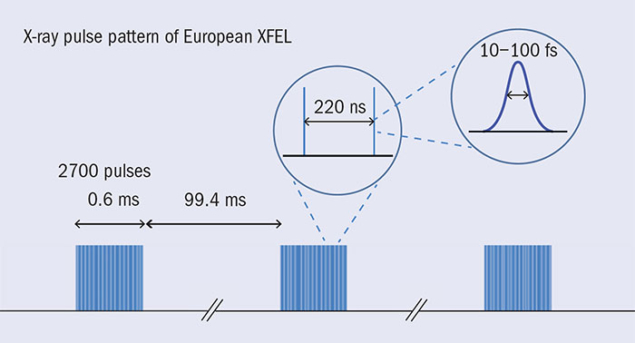
Indeed, the SASE pulses have potentially devastating power – especially close to the sample where the beam may be focused to small dimensions. A typical SASE X-ray pulse of 100 fs duration contains about 2 mJ of thermal X-ray energy (corresponding to 1012 photons at 12 keV photon energy), which means that a copper beam-stop placed close behind the sample would be heated to a temperature of several 100,000 °C and could therefore be evaporated (along with the sample) from just one pulse. While this is not necessarily a problem for samples that can be replaced via advanced injection schemes and where data can be collected before destruction takes place, it could shorten the lifetime of slits, attenuators, windows and other standard beamline components. The solution is to intersect the beam only where it has a larger size and to use only light elements that absorb less X-ray energy per atom. Still, stopping the X-ray laser beam remains a challenge at the European XFEL, with up to 2700 pulses in a 600 μs pulse train (figure 3). Indeed, the entire layout of the photon-distribution system was adapted to counteract this damaging effect of the X-ray laser beam, and a facility-wide machine-protection system limits the pulse-train length to a safe limit, depending on the optical configuration. Since a misguided X-ray laser beam can quickly drill through the stainless-steel pipes of the vacuum system, diamond plates are positioned around the beam trajectory and will light up if hit by X-rays, triggering a dump of the electron beam.
The business end of things
At the European XFEL, the generation of X-ray beams is largely “behind the scenes”. The scientific interest in XFEL experiments stems from the ability to deliver around 1012 X-ray photons in one ultrafast pulse (with a duration in the range 10–100 fs) and with a high degree of coherence. Performing experiments within such short pulses allows users to generate ultrafast snapshots of dynamics that would be smeared out with longer exposure times and give rise to diffuse scattering. Combined with spectroscopic information, a complete picture of atomic motion and molecular rearrangements, as well as the charge and spin states and their dynamics, can be built up. This leads to the notion of a “molecular movie”, in which the dynamics are triggered by an external optical laser excitation (acting as an optical pump) and the response of a molecule is monitored by ultrafast X-ray scattering and spectroscopy (X-ray probe). Pump-probe experiments are typically ensemble-averaged measurements of many molecules that are randomly aligned with respect to each other and not distinguishable within the scattering volume. The power and coherence of the European XFEL beams will allow such investigations with unprecedented resolution in time and space compared to today’s best synchrotrons.

In particular, the coherence of the European XFEL beam allows users to distinguish features beyond those arising from average properties. These features are encoded in the scattering images as grainy regions of varying intensity called speckle, which results from the self-interference of the scattered beam and can be exploited to obtain higher spatial resolution than is possible in “incoherent” X-ray scattering experiments (figure 4). Since the speckles reflect the exact real-space arrangement of the scattering volume, even subtle structural changes can alter the speckle pattern dramatically due to interference effects.
The combination of ultrafast pulses, huge peak intensity and a high degree of beam coherence is truly unique to FEL facilities and has already enabled experiments that otherwise were impossible. In addition, the European XFEL has a huge average intensity due to the many pulses delivered each second. This allows a larger number of experimental sessions per operation cycle and/or better signal-to-noise ratios within a given experimental time frame. The destructive power of the beam means that many experiments will be of the single-shot type, which requires a continuous injection scheme because the sample cannot be reused. Other experiments will operate with reduced peak flux, allowing multi-exposure schemes as also demonstrated in work at LCLS and FLASH.
Six experimental stations are planned for the European XFEL start-up, two per SASE beamline. The first, situated at the hard-X-ray undulator SASE-1, is devoted to the study of single-particles and biomolecules, serial femtosecond crystallography, and femtosecond X-ray experiments in biology and chemistry. SASE-2 caters to dynamics investigations in condensed-matter physics and material-science experiments, specialising in extreme states of matter and plasmas. At the soft-X-ray branch SASE-3, two instruments will allow investigations of electronic states of matter and atomic/cluster physics, among other studies. The three SASE undulators will deliver photons in parallel and the instruments will share their respective beams in 12 hour shifts, so that three instruments are always operating at any given time.
Eight years after the project officially began, the European XFEL finally achieved first light in 2017 and its commissioning is progressing according to schedule. The facility is the culmination of a worldwide effort lead by DESY concerning the electron linac and by European XFEL Gmbh for the development of X-ray photon transport and experimental stations. The facility is conveniently situated among other European light sources – synchrotrons that are also continuously evolving towards larger brilliance – and a handful of hard-X-ray FELs worldwide. The European XFEL is by far the most powerful hard-X-ray source in the world and will remain at the forefront for at least the next 20–30 years. Continuous investment in instrumentation and detectors will be required to capitalise fully on the impressive specifications, and the facility has the potential to construct about six additional instruments and possibly even a second experimental hall, all fed by X-rays generated by the existing superconducting electron linac. Without a doubt, Europe has now entered the extreme X-ray era.
The principle of SASE
Self-Amplified Spontaneous Emission (SASE), the underlying principle of X-ray free-electron lasers, is based on the interaction between a relativistic electron beam and the radiation emitted by the electrons as they are accelerated through a long alternating magnetic undulator array (see image). If the undulator is short, on the order of a few metres, and the undulating path is well defined with a small amplitude, the radiation emitted by one electron adds up coherently at one particular wavelength as it travels through the undulator. Hence, the intensity is proportional to N2p, where Np is the number of undulator periods (typically around 100). This is the regular undulator radiation generated at third-generation synchrotron sources such as the ESRF in France or APS in the US, and also at the next generation of diffraction-limited storage rings, such as MAX IV in Sweden. On the other hand, if the undulator is very long, the interactions between the electrons and the radiation field that builds up will eventually lead to micro-bunching of the electron beam into coherent packages that radiate in phase (see image). This results in a huge amplification (lasing) of emitted intensity as it becomes proportional to N2e, where Ne is the number of electrons emitting in phase within the co-operation length (typically 106, or more). The hard-X-ray undulators of the European XFEL have magnetic lengths of 175 m in order to ensure that SASE works over a wide range of photon energies and electron-beam parameters. High electron energy, small energy spread and a small emittance (the product of beam size and divergence) are crucial for SASE to work in the X-ray range. Together with the requirement of very long undulators, it favours the use of linac sources, instead of storage rings, for X-ray lasers.
On the other hand, if the undulator is very long, the interactions between the electrons and the radiation field that builds up will eventually lead to micro-bunching of the electron beam into coherent packages that radiate in phase (see image). This results in a huge amplification (lasing) of emitted intensity as it becomes proportional to N2e, where Ne is the number of electrons emitting in phase within the co-operation length (typically 106, or more). The hard-X-ray undulators of the European XFEL have magnetic lengths of 175 m in order to ensure that SASE works over a wide range of photon energies and electron-beam parameters. High electron energy, small energy spread and a small emittance (the product of beam size and divergence) are crucial for SASE to work in the X-ray range. Together with the requirement of very long undulators, it favours the use of linac sources, instead of storage rings, for X-ray lasers.




